SHARKS
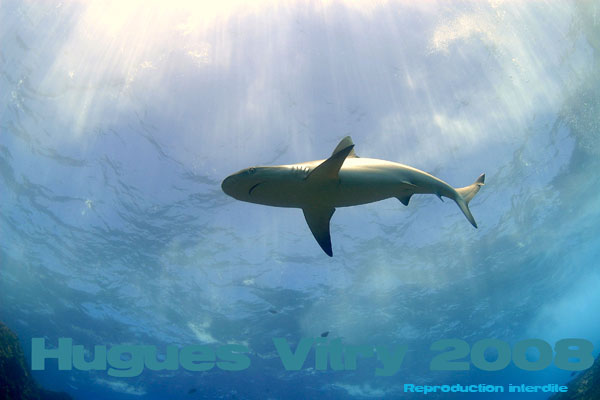
Sharks inspire as much admiration as they do fear. They are dreaded, hated and admired.
However, incidents and fatal encounters with sharks are rare.
Of the 350 species of shark, less than a dozen might constitute a danger for divers.
Nevertheless, they are wild animals in their natural environment and they must be respected and not annoyed or excited.
They are the most misunderstood and unknown creatures upon which there are so many false and inaccurate rumors and perceptions. One example of false perception is the common belief that sharks are immune to cancers. This is completely untrue!!! These creatures can develop internal and external cancers like other animals if they are exposed to severe and serious pollution as for example radiations coming from radioactive waste thrown at sea.
Another example of inaccurate preconceived idea about sharks is that if sharks stop swimming they die from asphyxia! Here again this is another false assumption because most sharks can actually stop swimming and rest on the bottom or in caves and they breathe by slowly moving their jaws. They would stop for resting, mating of giving birth. When they are in this situation, they enter a semi lethargically state. It is true that there are not yet a complete study on these animals.
Man has always tried to externalized his deepest fear by creating monsters, young they were named "bogeyman", later big bad wolf and to-day sharks is the monster par excellence on which man pours all his fear and hatred. Yet, a most tragedies involving sharks are most of the time accidental and shark kill less that a dozen humans per year against Hippos that kill many hundreds and crocodile kill a little less, mosquitoes kill hundred of thousands and man's best friend, dogs kill more than a hundred human per year. We do not want to include the wildest beast of all in the count.... voluntary or involuntary homicides caused by man
The few rares accidents that occurs involve most of the time surfers who know about the potential risk and still voluntarily put their life at stake, in rarest occasions it involve spear-fishermen and alas sometimes involving innocent swimmers.
Most of the time surfers yield and shout for the exterminations of sharks. But if we want to consider the risk they take we could compare it to allowing children on roller skates on the motorway or allowing the children out of the car in the African bush to play hide and seek. Everyone must act responsibly, and there shall be less accident involving sharks.
You find photos of some sharks below – the most common or the most impressive of the species encountered in the Indian Ocean and which you may see in Mauritian waters.
Gray reef shark, dagsit shark, black-tail shark
(Carcharinhus Wheeleri also called Carcharhinus Amblyrhinchos)
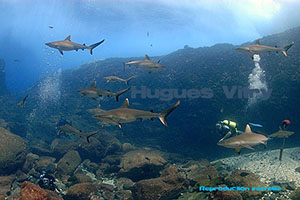
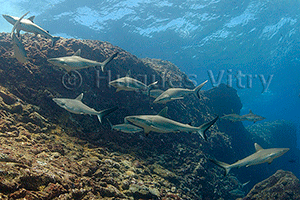
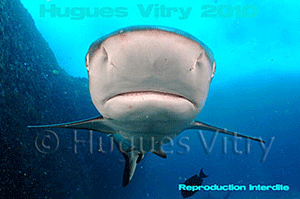
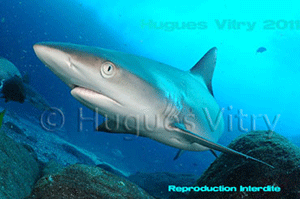
The blacktail reef shark is not a particularly large species. The biggest can reach 2.55m but the average adult size is 1.8m.They are highly social animals and tend to group together in areas where the water has a high oxygen content, which allows them to rest in the first part of the day. They leave such locations in the middle of the afternoon in order to take up position in their hunting areas.
In other places these sharks will rest on the bottom in underwater caves or range along underwater walls.
The sites where Blue Water takes divers where these sharks may be seen are:
Around Ile plate, Corsair's Wall, Banc Rouge. Coin de Mire.
Blacktip reef Shark (Carcharhinus melanopterus)
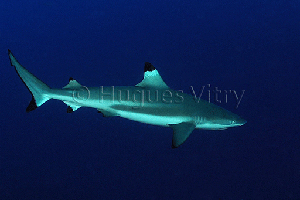
Black tip reef sharks grows most of time inside lagoon in very shallow waters, so shallow that sometimes their dorsal fins and tails are above the surface. Adults are more often seen in passes or external reef slope, but close to the fringing reefs.
It is of no real danger for humans.
Silver-tip sharks (Carcharhinus albimarginatus)
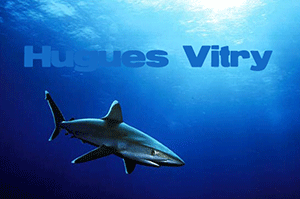
The silvertip shark is both jumpy and curious, living on reefs out to sea. It is sometimes found outside passes and often congregates in large groups at depths of 50m or more. But it also happens that on occasion it may come to just below the surface. Like many sharks, it becomes more or less invisible in the water as it moves away and all that can be seen are there triangular dots before it suddenly reappears behind or below you.
Bull Shark, Zambezi Shark (Carcharhinus Leucas)
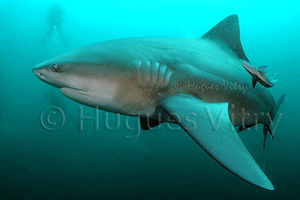
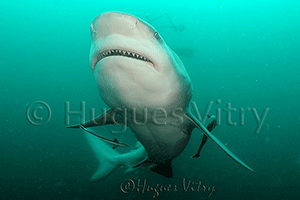
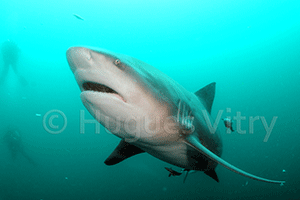
Bull sharks evolve most of the time in passes or near by reefs. The prefer murky waters of estuaries.

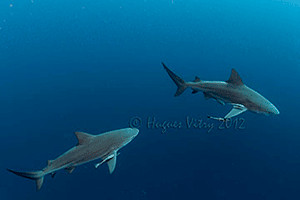
In clear water bull sharks can be seen swimming slowly one after the other very close to the bottom and when food is around the come up in a spiral swimming pattern.
Bull sharks tend to frequent passes and like areas where visibility is poor. They can also be found in clear water with breaking waves.
Bull sharks are opportunistic raiders and are often seen at the mouths of rivers and in river waters left muddy by floods. In these conditions it is an extremely dangerous predator for anything moving about on the surface.
They sometimes also venture into shallow lagoon waters, mainly at night, on the look-out for crustaceans and fish.
They may seem to be calm animals but have nevertheless clocked up the biggest number of incidents and accidents involving human beings. The greatest caution is advised when observing this animal.
The local dive sites where these sharks may be seen are:
Mon Choisy pass, Corsair's Wall, Amar, Caravelle.
Oceanic Sharks
Requin longimane ou océanique (Carcharhinus Longimanus)
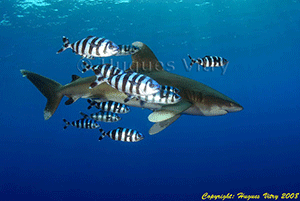
As its vernacular name indicates, this a shark that lives mainly in the open ocean and it can also be encountered around Fish Aggregating Devices (FADs).
As its scientific name indicates, one of this animal’s characteristics is the overdeveloped size of its pectoral fins. Other points aiding rapid identification are:
Rounded fins with large white blotches at their terminations and the khaki color that this shark takes on when near the surface.
An eye needs to be kept on this shark because it knows no fear and may calmly and collectedly aim for a swimmer or diver, and if it gets a chance taking a nip just to explore the taste.
This is one of the rare predators that can succeed in taking a “little” bite. If it does not, it will swim behind a diver who ignores it but may make a charge from the side.
The greatest caution is advisable when encountering these marvelous animals, despite their apparently tranquil behavior.
In our region, Fish Aggregating Devices (FAD) remain the only possible places where encounters are possible.
Silky Shark (Carcharinhus falciformis)
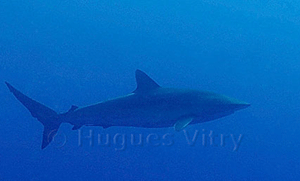
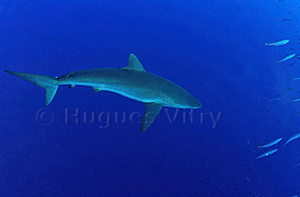
The silky shark lives in oceanic waters like the whale shark and oceanic whitetip shark.
They have no fear of approaching divers.
Oceanic Blacktip Shark (Carcharhinus limbatus)
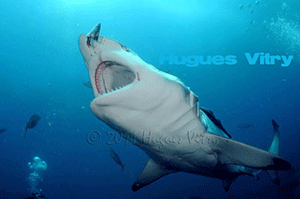

Thresher Shark (Alopias vulpinus)
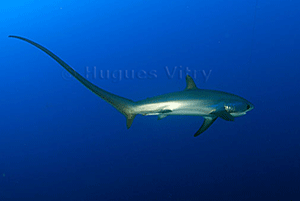
This is a shy animal that often lives at great depths but may also come up nearer the surface along undersea walls, staying at around 20m. Rarely seen at the surface, but when it does its large tail will stick out of the water and move in zigzag patterns or flop down on the water’s surface.
It is easy to identify given its excessively large tail, cylindrical body, large black eyes and small mouth
The white part on the bottom of its body shines brightly when lit.
The Great White Shark(Carcharodon carcharias)


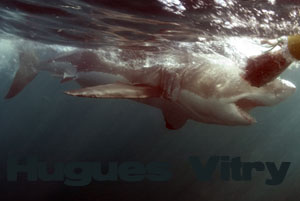
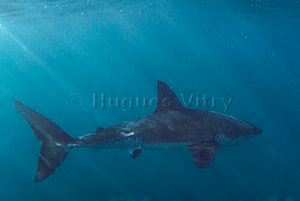

One of the biggest marine predators still living. The Great White can be up to 6.5m long in the case of the largest females. Average size is between 2.5m and 4m.
The Great White belongs to the Lamnidae family and has a tail that is more or less symmetrical (the lower and upper sections are roughly the same size) and has a robust keel in front of the tail. It has a very striking color ranging from gray-brown to black on its back, sharply contrasting with the whiteness of its belly – hence the name Great White!
This shark is very rare in Mauritian waters but there have been some sightings in recent years.
These have been in the south of Mauritius and around the northern islands.
Some Great Whites have been caught by sports fishermen but fortunately this is very rare. The species is protected by the CITES Washington convention (providing protection for highly endangered species), see: http://www.cites.org/ and http://www.cites.org/eng/resources/ID/index.ph; click on “Fauna” and “Species” before selecting “Elasmobranchii” in the list.
Although highly protected on the coasts of South Africa, California and Australia, these animals are vulnerable when migrating in international waters, where they are caught in fishing nets and on “long lines”. Unfortunately for them, animals are no respecters of international borders.
The larger specimens are solitary individuals of impressive size and teeth. They feed essentially on other large fish, sea lions, seals and dead whales, whose fatty flesh they find delicious. They may group together in a given area for the time needed to hunt or to feast on the spoils.
This species prefers temperate waters (12- 22ºC) a fact that means encounters are exceptionally rare in Mauritius.
However, it is not uncommon to see a community form at the same place each year in Australia or South Africa near small islands where seals congregate. Attacks on the latter are impressive. Great White sharks come up from below and snap up the unfortunate prey at the surface, throwing them up into the air. Alternatively, they may leap up from the water and bear down on their prey. Sea lions and seals sometimes manage to escape, despite being injured.
The Great White is often accused of attacks on swimmers and surfers of which other sharks are in fact the culprits, bull sharks especially. That being said, the Great White must be considered to be potentially dangerous, even if it might appear, according to what we ourselves have observed, to tend to be shy and curious.
A Great White catching a seal lure in an attack (South African coast)
Tiger Shark (Galeocerdo cuvier)
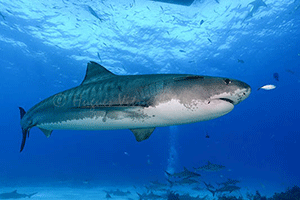
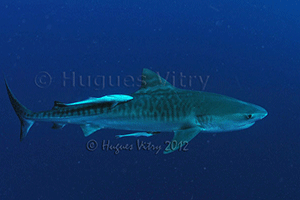

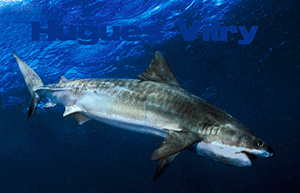
This is a large shark living in both deep and shallow water. It sometimes sets up home in a given area due to the presence of a regular food source.
It is often found near floating carcasses of large marine mammals.
It has a large mouth and square snout and vertical bars along its body, terminating in green patches at the top of its belly.
Its head is massive.
The usual size of this animal is in the range 2.8 to 4m, but the biggest specimens may reach 6 meters.
Scalloped hammerhead Shark (Sphyrna lewinii)
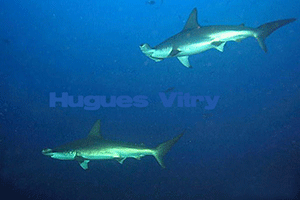
All scalloped hammerhead sharks live in the open sea on deep reefs.
They may be observed early in the morning in groups at significant depths (> 40-50 meters). They occasionally come up to the surface.
Around the full moon in December the females come into shallower waters to give birth to between seven and twenty young.
Their usual size is 2.8m and the biggest may reach 3 to 3.5m.
The Great Hammerhead Shark (Sphyrna mokarran)
The great hammerhead shark is a solitary animal that is impressive due to the size of its body and its dorsal fin. It is quite rare on the reef plateau but it is sometimes encountered alongside the deeps.
Blue Shark (Prionace Glauca)
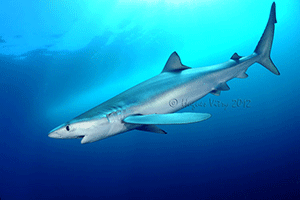
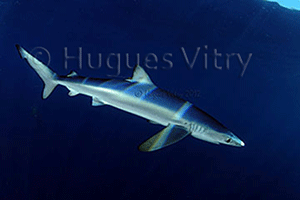
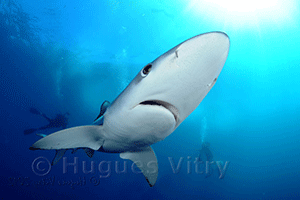
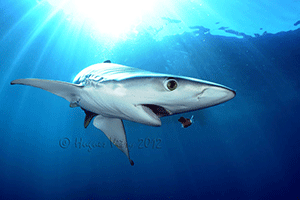
Tawny nurse Shark (Nebrius ferrugineus)
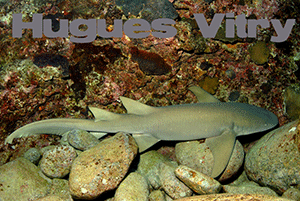
This shark is commonly seen in cavities in the reef, where it spends its time lying on the bottom during the day. At night it goes out in search of a meal of crustaceans and shellfish, or small fish.
It is usually up to 2.50m long but can reach 3.2m.
The sites where Blue Water takes divers where these sharks may be seen are:
Corsair's Wall, Stenopus Reef, Roches Baleines, Coin de Mire, Banc Rouge.
Whale Shark (Rhincodon typus)

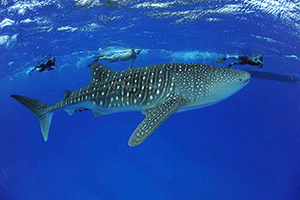
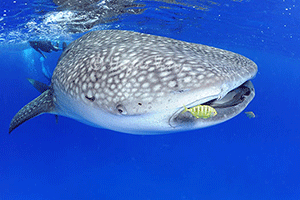
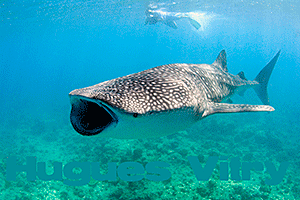
This is the world’s biggest fish – up to 12m long, but with a more usual size of between 4 and 8 meters. It is described as a plankton eater but it can frequently be seen to mop up part of a shoal of fusiliers. It is a slow, elegant animal that is totally inoffensive. It can be seen migrating in the deep water around Mauritius on occasion and, rarely, may come in closer to the coast, to the great pleasure of a few lucky divers.
Shortfin Mako Shark (Isurus oxyrinchus)
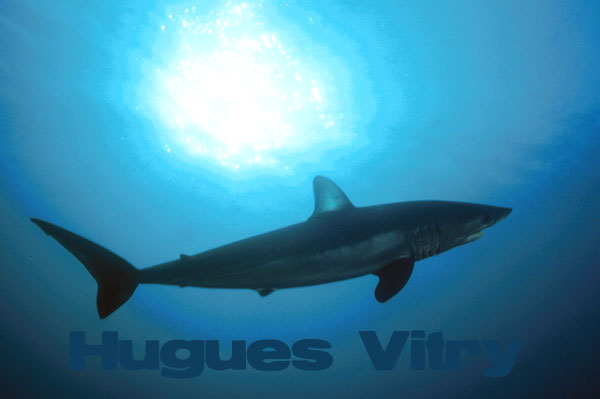
Mako sharks belong to the same family as the Great White (Lamnidae) and they also have a more or less symmetrical tail (i.e. the lower and upper tail sections are roughly the same size) and they have a robust keel in front of the tail and very wide gill openings.
The mako may reach a maximum size of 4m but the average for those actually encountered rarely exceeds 2.5 to 3 meters.
They can make spectacular leaps high out of the water. When caught on a fishing line they jump out of the water, simultaneously turning to wind the line around their body and fighting powerfully to free themselves. And in fact they can break a fishing line fairly easily, hence their nickname “blue dynamite”.
This is the fastest shark in the ocean after the blue shark and can reach peak speeds of over 60kph and an estimated 110kph when attacking a shoal of fish.
This is a pelagic animal and is rarely seen in coastal waters. The rare observations made are near Fish Concentration Devices (FCDs), subsea mounts or small oceanic islands.
Whitetip Reef Shark (Trianodon obesus)
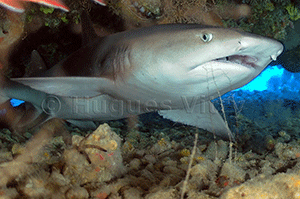

This is a shy animal that spends most of its time hiding on the bottom or in cavities during the day. It is very active at night and forms groups to hunt any small fish and squid that incautiously venture their way.
Its length can exceed 2 meters.
The sites where Blue Water takes divers where these sharks may be seen are:
Corsair's Wall, Stenopus Reef, Coin de Mire, Roches Baleines, Banc Rouge.
This shark is harmless to human beings unless an attempt is made to catch it, in which case it is capable of defending itself, leaving a nasty bite.
Lemon Shark ( Negaprion brevirostris)

The Shark depicted in this pictures is a little different to the sharks found in the Mauritian lagoon (Negaprion acutidens)
Our local sharks are more yellowish-gold color on the back. These shark are present in the lagoon of the northern island of Mauritius and paradoxically, the adult form of the shark are not quite rare outside the lagoon.
Lemon sharks are quite placid and never aggressive may be unless if annoyed or harassed.
They can exceed 3 meters in size. New born and young are present in mangroves and in lagoons and the adults spend most time during the day resting on the sand.






